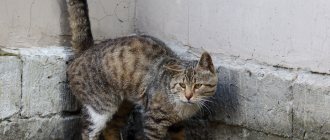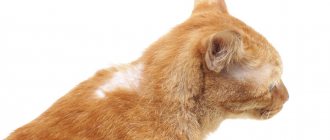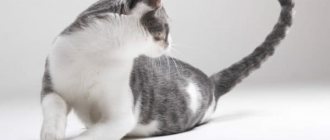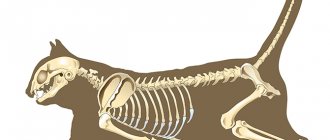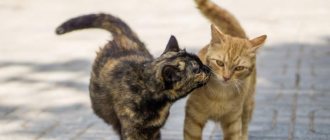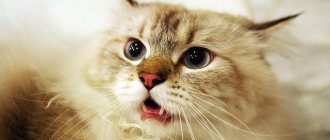The strange behavior of a cat after a haircut has a number of reasons and explanations. No matter how high-quality the procedure is, the animal experiences stress and discomfort during and after it. You should not take your pet to a groomer solely for aesthetic purposes. The main motivation should be to help the cat survive the heat or get rid of a blob of fur. If you do not consistently take care of your pet’s appearance, a number of dermatological problems will overtake it. To better tolerate the adaptation process, there are a number of rules and tips to help the owner.
Grooming cats, how long does it take for fur to grow?
Pet hygiene is one of the essential procedures. It is not enough to simply feed and pay attention to your cat. And if cutting nails or bathing are necessary procedures, then grooming is a separate issue. Currently, there are fierce debates not only among owners, but also among professional breeders regarding this procedure.
Opinions vary radically. Some claim that this is dangerous and nature will take care of them itself, for example, seasonal molting. Others are convinced that the aesthetic side of the issue is extremely important. Especially for pets who participate in exhibitions. So, if you cut a cat's hair, how long will it grow?
Let's consider the issue from the point of view of hygiene and aesthetics. Let's try to find a middle ground. Let's answer the question, what are the dangers of frequent haircuts? Looking ahead, it should be noted that the truth lies somewhere between two opposing opinions.
Correct haircut
To make the fur reduction procedure on your cat more comfortable, you should immediately bathe the furry cat after cutting it. This is done so that the remaining fur does not prick and cause itching. It is advisable to praise the cat more, pet it, and pay attention to it so that it feels calmer. If the animal begins to shiver from the cold and look for a warm place, it is better to dress it or cover it with a blanket so that the body gets used to the temperature. It is necessary to remove piercing and sharp objects from the cat’s habitat so that the pet does not get hurt by them.
When is a haircut necessary?
The procedure, especially nowadays, is an extremely fashionable procedure. Grooming is practiced even by owners whose pets spend 99% of their time within the walls of an apartment or house. Let's try to determine the reasons for the hygiene procedure, which lie in the motives of the owners of pet purrs. So, in what cases should a cat's fur be trimmed?
Get rid of skin diseases. Quite a controversial decision, because... in this case there is a struggle with the effect, not the cause. This is only partially justified. For example, when a veterinarian clips individual areas to identify the main foci of infection.
Haircut is often practiced for lichen. At home, if you shave the cat down to the undercoat, the problem will not go away. The animal will continue to go bald.
Establish heat transfer. There is an opinion that cats do not tolerate heat well precisely because of the abundance of fur. This is partly true. They tolerate high temperatures of 38-40 °C just as poorly as the vast majority of people. Grooming partially alleviates the animal's suffering. Cat fur does not grow back quickly. An additional danger arises. For example, the influence of drafts, air conditioning, direct sunlight.
Get rid of tangles. Let's leave the aesthetic side of the issue for a moment. Yes, tangles are, to put it mildly, ugly. But the problem is much deeper. If for some reason the owner does not comb the cat's fur, tangles will form. The area underneath is a favorable environment for the life of microbes and other fungi. The cat experiences itching, burning, and itches constantly.
Combing prevents the formation of tangles. Be prepared that the cat will not allow itself to be trimmed, so to get rid of matted fur you will have to resort to tricks. In this case, you cannot do without the help of a partner.
ATTENTION! In general, brushing and trimming are more important for long-haired breeds.
Seasonal molt . Numerous wool on the floor and furniture is a real problem for the owners. And not just long-haired cats. Even after a haircut, the cat will grow again and shedding will continue. If it drags on, it is advisable to contact a veterinarian. Reasons include high indoor humidity, stress or poor diet.
Aesthetic pleasure. On the Internet you can find a huge number of photographs of trimmed cats. Considering that they take quite a long time to grow, such a model haircut will allow you to participate in a couple of exhibitions. This is what many breeders and owners are unhappy with.
In particularly advanced cases, they compare it to animals being in a zoo. Roughly speaking, a model haircut does not help the cat in any way, but only brings aesthetic pleasure to others. However, everyone has different tastes, which is why the question causes heated discussions.
Allergy to wool. People with upper respiratory tract diseases are not allowed to have pets. Sometimes a total haircut helps, but, for example, a Maine Coon will quickly grow overgrown and the problem will not go away. A good option would be to buy Sphynxes, but not all owners like these specific breeds. Although many people note the kindness and affection of hairless cats.
Unfortunately, many people who are allergic to wool simply refuse to buy an animal.
Avoid getting wool into the gastrointestinal tract. Everyone knows that cats are notoriously clean. By licking the fur, some of the hair gets into the pet's mouth and beyond. In advanced cases, the cat may vomit huge pieces of hair. But this process is better regulated with the help of timely combing, trimming and even bathing.
Mr. Cat recommends: methods to help with stress
If your cat is stressed, the first step is to find and, if possible, eliminate the cause. Of course, some factors cannot be corrected, but it is quite possible to alleviate the condition, and the task of a caring owner is to help his pet.
In order to somehow mitigate the situation and neutralize the impact of stress factors, both psychological support methods and drug treatment can be used.
Psychological help
First of all, you need to try to help your pet psychologically. It is impossible for the sake of a cat to return to an old, already sold apartment, much less to revive a deceased owner. However, it is still possible to make the animal’s life easier.
Domestic cats, like people, need manifestations of love; they need to feel not only care, but also warmth and affection. For a pet, such manifestations are tactile contacts with a person. Not all of them like to sit in their arms, but if the animal prefers to spend its time in the arms of a person, then you need to provide it with this pleasure in full. Even those who don’t like to sit on their owner sometimes want to sit next to them and want to be petted.
For a cat, this is both a physiological benefit, massage, and emotional pleasure.
Pets, of course, are not able to communicate verbally with humans, but it is no coincidence that these animals have a wide range of vocal signals. By making various sounds, they “talk” to a person, and they also need to be spoken to. Precisely with the voice. Of course, they don’t understand words, but they feel intonation perfectly. Therefore, it is necessary to express your love and tenderness for the cat with your voice, talking to it.
If your pet loves to play, she must be constantly provided with toys.
Most pets love a treat, and owners should pamper their animals more often if they are under stress. This way you can smooth out the situation and distract from your worries.
During necessary but unpleasant procedures, you need to reassure and support her: both tactilely, so that she feels supported, and with your voice.
Also read the article on how you can calm your cat.
Medication methods
If psychological assistance measures are insufficient, then you can try to help the animal with medication. Before giving any medications, your cat should be taken to a veterinarian and examined.
Today there is a large selection of stress relief products available for cats. To rid your animal of emotional problems, you can try various preparations with pheromones (these substances have a calming effect on the animal). They are available in the form of sprays, fumigators, and there are also special collars.
Catnip is sold in pet stores; this herb is also good for fighting negative emotions. It causes a surge of excitement, after which the cat calms down.
Giving tincture of valerian root to an animal for the same purposes is strictly not recommended.
In some cases, when your pet's stress and anxiety levels are very high, your veterinarian may prescribe human antidepressants.
This should be done exclusively by a specialist; he will be able to correctly calculate the dosage for a particular cat. Under no circumstances should you give antidepressant tablets on your own.
To calm and relax your pet, you can try aromatherapy. This method helps both people and animals, whose sense of smell is much better developed.
It is necessary to use essential oils and substances (in aroma lamps or in the form of special sticks) that have a sedative effect (lavender, neroli, ylang-ylang, bergamot, mint, cedar).
To prevent stress, you can use drugs that have a cumulative effect. If you know in advance about a trip to the veterinarian, hairdresser, moving, or other events that cause negative emotions in your pet, then you can prepare the animal by starting to give it sedatives ahead of time. In this case, he will cope with a stressful situation much easier.
Do you need to cut your cat's hair? Pros and cons of the procedure, practical advice
The nuances of the appearance of hair in cats after a haircut
Quite often, owners of felines notice that the cat’s hair does not grow for a long time after a haircut. We propose to analyze why this happens and what to do about it.
How the problem manifests itself
Of course, owners are concerned about why problems may arise with restoring the coat and how quickly the cat will grow back after a haircut. If the “fur coat” is not renewed for more than 6 months, the animal has alopecia – delayed fur growth. It is determined by the following criteria:
The most common stressors
The owner’s task is to protect the animal from stress. Each owner knows the character of his pet and understands which events or actions will cause him psychological discomfort, and which he will survive calmly. Thus, some breeds are quite loyal to water and even love bathing, while for others the washing procedure is a real stress and shock.
They are forced to adapt to the owner’s lifestyle, and they prefer to follow the rules learned from childhood. Orderliness is the basis of a cat’s life; they do not like surprises and changes. Anything that disrupts the usual course of life is quite difficult for these animals mentally.
The strength of the nervous system varies among all breeds. They also differ in temperament. Cats can also be divided into sanguine (they tolerate stressful situations quite easily), choleric (they can cope with stress quickly), phlegmatic (they prefer not to show emotions) and melancholic (they experience stress the hardest).
Various reasons can lead to stress. They can be divided into external and internal (physiological and psychological).
External influences
External influences are the most common group of causes of stress in cats. Any changes in their daily routine cause discomfort to these animals.
The level of stress may vary, but any external influences that are “not included in the plans” of the cat make it worry.
Negative external influences include the following.
Read: why a cat is afraid of water and what to do about it.
A trip to the veterinary clinic
Leaving a habitable and recognized safe territory is already stressful. She is put in a carrier and forcibly taken out of her comfort zone. Not everyone handles travel well, so for many of them this is another reason to worry. Then the cat finds herself in an unfamiliar room filled with strange, sometimes very irritating odors, and strangers begin to touch her.
If procedures are necessary, and even unpleasant ones, then the animal generally begins to experience real panic. Some owners notice that after visiting the veterinarian, the cat's hair begins to fall out. This is the same common reaction to stress as in humans.
Visiting the cat groomer
Here the order is the same as in the previous case. Plus, unpleasant procedures are guaranteed. If an animal visits a “cat stylist” from an early age, it can tolerate his manipulations quite easily.
If the cat is unaccustomed to haircuts, washing and other procedures, then they will become a source of very strong stress for her.
Departure of the owner, foster care
Many owners do not have the opportunity to take their pet with them, for example, on a business trip or on vacation. Some simply do not want to expose the animal to stress, especially if it suffers from seasickness and does not tolerate travel in public transport. Then, if it is necessary to leave, it is given to friends, relatives or people who professionally care for animals.
The latter are the most preferable solution, since such people find out the pet’s habits and routine and try to provide her with the most comfortable conditions. In any case, a change of place, new smells, a change in the usual daily routine is stressful for a cat. In addition, she does not understand that this is temporary, and may have a hard time worrying about it.
The arrival of a new family member or pet
Cats, like people, can be jealous and feel that they are not getting enough attention. The birth of a child is easier for her to bear, but finding methods of communication with another animal is much more difficult.
If this is a baby, then the cat or cat can take “patronage” over him. When he becomes an adult, conflicts may occur. In any case, the appearance of a new character on the territory that the pet considers its own, habitable, plunges the animal into a stressful state.
Repair
This is a real hell for a cat: sharp sounds, smells, changes in the environment (for the sake of the animal’s safety, everything needs to be controlled), constant fuss. If workers are hired, this is also a source of stress, because most breeds are wary of strangers.
The daily routine changes, and the owner may forget to fill the bowl because he is too busy. There may also not be enough time and energy for the communication that a cat is accustomed to.
Some owners, trying to protect the animal from stress and remove dirt and dust, lock it in another room. This can also cause psychological trauma to it: after all, it does not understand the source of sharp sounds and cannot control what is happening behind the door.
Holidays, parties, arrival of guests
The sensations are approximately the same as during repairs, only the horror ends faster. Cats are suspicious of new people with unfamiliar smells.
If they also try to communicate with the animal (especially if it doesn’t like “strangers”), then they’re basically on guard.
Firecrackers exploding outside the windows, causing severe fear, and changes in the daily routine can add “sharpness” to the New Year’s holiday. The owner's consumption of alcohol can cause bewilderment in the animal: the smell, facial expressions and behavior of familiar and loved ones change. From a cat's point of view, these are all reasons for negative emotions.
Moving, change of residence
This is the biggest stress for cats. Despite the fact that they become attached to people, they are no less attached to a place. This is due to the fact that she considers the inhabited and fully surveyed territory to be more or less safe. From her wild ancestors she inherited instincts that force her to control what is happening around her for her own safety.
New territory means the need to survive at any cost. Therefore, many owners note that it is impossible to find a cat in a new home at first.
Sometimes they hide for several days until severe hunger forces them to leave their shelter. And even then, having left the shelter, the cat moves around the new house very carefully, in short dashes, constantly returning to the shelter.
Familiar things can help you get comfortable in a new place: a house or bedding, toys.
Diseases and physiological causes
If a cat is sick, this immediately affects its emotional state. Any problems in the body make this predator feel vulnerable. The stronger the symptoms of the disease, the higher the stress level.
They experience minor discomfort more easily than severe pain or other intense manifestations of the disease.
The most common and serious physiological stress factor is parasitic infestations. Infection with helminths causes indigestion, deficiency of nutrients and vitamins, and an increase in symptoms of intoxication. If fleas, subcutaneous parasites appear, or she catches a tick, she experiences itching, pain, discomfort, and in some cases, severe weakness. In such a situation, the cat experiences irritation from itchy skin and weakness. In addition, mites can cause serious infections.
Infection with lice and fungal diseases also causes significant discomfort. The feeling of one’s own weakness deprives one of confidence in safety and the ability to fight for one’s life.
This condition causes deep emotional experiences in the animal.
Pain, both acute and aching, causes no less stress in the cat. Its cause may be:
- injuries;
- surgery or invasive medical procedures;
- unsuccessful mating.
Emotional reasons
In diagnostic terms, the psychological causes of stress are the most difficult. If there are no external negative influences, the animal is healthy, but there are signs of anxiety and stress, it is very difficult to figure out what is happening to the pet. It is necessary to analyze the situation in the house and your own behavior, find out what exactly the cat has a negative reaction to.
Psychological problems may arise in the following cases:
- death of a family member;
- change of owner;
- tension, difficult atmosphere in the house, conflicts between people, especially accompanied by loud sounds or assault;
- loneliness, feeling of uselessness, abandonment;
- jealousy, feeling of lack of attention;
- fears and phobias.
How long does it take for fur to grow back?
In general, for most breeds the terms are more or less equal. Cat hair grows more slowly than human hair. Approximately 1-1.5 cm per month. The average period can take up to 6 months. This is the answer to the question of how quickly a cat’s hair grows.
ATTENTION! Of course, one should not exclude individual characteristics, nutrition, hereditary and acquired diseases and other external factors.
Hair reaches a certain height. Then he stops. Gradually it will fall, giving way to new lint. It is important to understand that a total haircut leads to the fact that developing hair is also destroyed. This can cause serious harm to your pet in the long run. But more on that later.
How to speed up the process
A cat's fur, like that of any other animal, goes through 3 stages of growth:
Hair reaches a certain length. Then its development stops and, after a certain time, the hair falls out, giving way to a new one. The cut pile is mainly in a catagen state. An exception would be a haircut to zero, when the developing hairs are also cut off.
Most of the fur coat will not grow back. Fresh anagen hairs will form a new coat after the cat is groomed. How quickly wool grows depends on a number of factors:
- Diet. To speed up the restoration of “hair”, your pet needs proteins. Experts recommend that their share per dry weight be at least 30%. Hair growth is also stimulated by zinc, vitamins and fatty acids. The cat can receive them with food (meat, cooked yolk, sea fish) or nutritional supplements.
Ambient conditions. In nature, animals grow overgrown before frost and molt with the arrival of warmer weather. Cats living in the house are less affected by this cycle, but the connection remains. Wool grows faster in spring and summer. In winter, the process of hair change slows down. By deciding to cut your pet's hair during the warm season, the owner will quickly see his original fur coat. This is a practical solution - animals shed less during the cold season.
Care. Regular combing stimulates hair change. It is also necessary to monitor your pet's stress level. A nervous cat may shed a lot. In this case, new follicles are not activated. If the source of stress persists, the coat thins, even to the appearance of bald patches.
The fur has grown back faster, you need to provide the cat with proper nutrition. You should not imitate warming - too high a room temperature will cause molting, but will not awaken the follicles.
Overheating will also negatively affect the health of your pet and other residents. It is better to cut it in the warm season, with natural accelerated hair change. Although, during the cold season, the hairstyle will last longer.
Causes of delayed hair growth
If after 3-4 months the cat’s fur does not grow after being cut, it is worth showing him to the veterinarian. It is possible that the follicles have not entered the anagen phase. But there are other reasons:
- bacterial and parasitic infections - waste products of pathogens poison the body, affecting various organs, including the skin;
hormonal disorders - hair growth can be hampered by malfunctions of the adrenal glands, changes after sterilization, ovarian tumors and other conditions;
weakening of the body due to illness or stress.
Thus, the hair on the area shaved for surgery (examination) may grow back more slowly than with a regular haircut. The age of the pet is also taken into account. The tissues of older cats recover more slowly compared to young cats.
Delayed hair growth can be observed in females during pregnancy or nursing offspring - the body is focused on other tasks.
Is it worth getting a haircut?
A pressing question, given the role of fur in a pet’s daily life. She helps:
- protect the body from mechanical injuries and ultraviolet radiation;
maintain normal temperature in cold and warm environments;
assess the environment - the villi are not as sensitive as the whiskers (whiskers), but they are also involved in tactile perception;
communicate - by fluffing up its fur coat, the cat tries to visually increase in size in order to influence the enemy.
Grooming can deprive your pet of its protective layer and cause severe stress. This problem arose in a four-year-old cat named Ollie from a small British town. The Mirror published his story in the summer of 2015.
The animal was cut to zero - the hairdressers stated that such a measure was required due to the abundance of tangles. According to the owner, after the procedure the cat was depressed, did not want to leave the room and obsessively demanded people's attention. The dogs living in the house also stopped recognizing him.
Why does the animal run and nervously lick itself?
Licking is normal for cats. These clean animals are so sensitive to the cleanliness of their fur that they lick themselves at every opportunity: after eating, going to the toilet, or being touched by their owners. Moreover, by licking their fur coat, they calm down. Licking can be talked about as a normal phenomenon only when it is not fanatical in nature. Why does a kitten or adult cat run around the house and lick nervously?
The cat is stressed
These animals have a very vulnerable psyche. It doesn’t take much for a pet to lose its peace of mind. This can happen due to a trip in a car, a visit to the veterinarian, quarrels in the family, the appearance of a new four-legged inhabitant in the house, moving to another room, changing place of residence, etc. All cats experience stress differently. Some begin to run aimlessly around the apartment and fanatically lick the fur. Sometimes they do this so violently that in some areas of their bodies they become completely bald.
As soon as the factor that provoked the cat’s emotional shock disappears or he gets used to new circumstances, the pet will stop being nervous. However, cats are not always able to overcome stress on their own. Sometimes they need sedatives.
Hyperesthesia syndrome
This rather rare disorder, affecting the skin, neuromuscular and nervous systems, is most often detected in kittens. The reasons for its appearance are unknown, but it is believed to be due to disruption of neurotransmitters in the brain during anxiety.
Animals with this syndrome feel tense all the time and experience increased sensitivity to touch. Their spine and tail are the most vulnerable. They lick the fur too diligently, paying special attention to the most vulnerable areas of the body, sometimes leading to the appearance of bloody wounds. Hyperesthesia syndrome can also be recognized by other symptoms:
- nervous tail beating;
- twitching of parts of the body in the back;
- sudden bursts of activity, sometimes developing into aggression;
- dilated pupils;
- tail biting;
- loud meow.
The cat has fleas, worms or other parasites
The reason for this behavior may be ecto- and endoparasites. They cause the pet a lot of suffering. Especially unbearable for them is the endless itching in places affected by external parasites, such as fleas. It prevents the tailed poor fellows from sleeping peacefully, eating, and spending time carefree. In order to somehow drown it out, they begin to rush around the house and actively lick the irritated skin, often only aggravating the situation.
Having noticed symptoms of a helminthic infestation in a cat, it is necessary to take measures to destroy the pests as quickly as possible. Antiparasitic drugs, especially if they are planned to be used to treat a kitten, should be discussed with your veterinarian.
In what cases is it contraindicated?
Experts note the three weakest areas, where hair removal can be dangerous for your pet:
Experts have an extremely negative attitude towards total haircuts. The optimal hair length, if you really want or need treatment, is 0.5 - 1 cm. The hair will no longer bother the owners, and the protective layer is preserved.
The naked animal should be covered with a cotton cloth to avoid direct exposure to sunlight. This will avoid burns or prevent the development of cancer.
It is important to understand that the lack of hair can negatively affect a cat's psyche and communication. Apathy, loss of appetite, ignoring the owners are not uncommon situations after a total haircut.
In addition, wool is one of the main tools in the fight for territory or a female. A naked animal may simply not be perceived by competitors. The situation is especially relevant for owners of private houses. A cat that has lost a war for territory several times will be afraid of its rivals, “invite” it to visit and even share food. Often the neighbor's cat will completely take the loser's food away.
IMPORTANT! Due to hypothermia after cutting, in some places the hair often does not grow back. You should carefully monitor your pet's heat exchange, especially in winter and autumn.
What is required for the procedure
Of course, it is better to entrust the procedure to professionals. But a simple, cosmetic haircut can be done at home. What devices are best to have on hand?
In most cases, you will need the help of a partner. First, for safety reasons, you need to trim your pet’s claws.
Here are some common recommendations that will help speed up hair growth in cats:
Ultimately, it does not build to abuse the haircut. Pay special attention to exhibitions, because Hair loss leads to numerous unpleasant consequences, ranging from diseases to communication problems.
Cats' fur takes an average of 6 months to grow. The optimal hair length after cutting is 1 cm. The best time for cutting is spring-summer.
Why does the animal’s behavior change after the procedure?
Professional grooming does not cause physical harm - the professional acts carefully and as quickly as possible. Most injuries occur when trying to solve a problem on your own. If animals behave strangely after a haircut, this is the first sign of stress. Without the help of the owners, the cat develops and worsens severe depression.
Unusual conditions and unusual actions of a stranger
After a haircut in a salon, some animals begin to hide, avoid the owner’s attention, and demonstrate an aggressive attitude towards family members. The problem is associated with traveling to an unfamiliar place, noise, strangers and other pets. Some experts advise calling a hairdresser to your home - this will reduce the level of tension. The care of the specialist after the procedure will convince the cat that the source of the trouble has disappeared.
Veterinarians recommend carrying out manipulations in clinics or special salons - at home, the animal should feel safe, and not wait for the unpleasant person to return. The decision about where to receive hairdressing services depends only on the owner.
Effect of anesthesia
The influence of medications can reduce discomfort in a cat, but anesthesia itself is a serious test for its body. Sedative medications affect the functioning of the respiratory, cardiovascular and other systems. For this reason, grooming is carried out strictly according to indications, taking into account the individual characteristics of the animal’s body.
Before the procedure, the cat undergoes an examination, the owner is informed about the possible risks - sedation is contraindicated in case of heart disease. Most pets do not need medical assistance: an experienced groomer can easily cope with the manipulation without it.
Anesthesia and haircuts on the first day provoke inappropriate behavior in cats: they lose orientation in space, constantly sleep, or attract attention to themselves with mournful meows. Veterinarians advise avoiding sedation whenever possible to avoid side effects from medications.
Unusual sensations of a cat after a haircut
Changes in the amount and volume of fur can cause non-standard manifestations in animals:
- cats cannot lie down after being trimmed - short hair causes unusual sensations when in contact with any surfaces;
- freezing - a small draft provokes attempts to hide in a blanket, under a blanket or on a shelf with linen;
- refusal to communicate – the unusual appearance irritates the pet;
- hunger strike or continuous consumption of food - refers to manifestations of distress;
- hunting for your own tail.
Why can’t cats be cut and how long does the fur of long-haired cats grow?
Grooming cats is a newfangled invention that has received a large number of fans and opponents. Veterinarians are against such excesses and are confident that you can cut your pet’s hair only when necessary, and not for your own pleasure. Animals do not react well to imposed changes; they may become depressed, hide from their owner for a long time, or begin to take revenge.
Why do pets get haircuts? Why is hair cutting and shaving of cats not recommended by experts? What consequences can result from ignoring the opinion of veterinarians?
Why is it not recommended to groom cats?
Veterinarians and professional breeders have a negative attitude towards trimming the coat at the whim of the owner. The main danger of haircuts is the high probability of changes in the structure of the hairs. The newly grown coat may become thinner and its quality may deteriorate, leading to the rapid formation of tangles. The changes also affect the cat’s skin – its elasticity and firmness may decrease.
Cooling has a negative effect on proper hair growth - in bare areas the skin temperature decreases. Some pets develop patches of baldness - the cut hair does not grow back. The problem of alopecia is more common in canines, but some felines also experience it.
Purebred pets may lose the right to attend exhibitions: after clipping, the hair begins to curl, becomes excessively fluffy or short. Such conformation defects are the main reason for the disqualification of cats.
Not all pets calmly allow their appearance to change. To obtain a fashionable hairstyle, the animal is put under anesthesia, which can seriously harm its health. In rare cases, the procedure ends in death for the cat - under the influence of the drug, cardiac activity and breathing stop.
A cat’s beautiful hairstyle pleases its owners, not the cat itself. An incorrectly trimmed tail can even cause your pet to try to chew it off.
The cat's tail and skin on its back twitch - why and what does this mean?
Cat owners sometimes observe the following picture: the pet's tail twitches, as if he is marking territory, and the skin on his back shakes, as if he is trembling in this particular part of the body. This phenomenon may have physiological and pathological causes. Regardless of what exactly led to the twitching of the tail and skin, the four-legged pet in this situation requires the help of the owner.
The animal has fleas or other ectoparasites
If an adult cat or kitten twitches its tail, while the skin on its back trembles, it may be overcome by ectoparasites (those that parasitize not under the skin, but on its surface): fleas, lice eaters, ticks. In addition to these symptoms, external parasites manifest themselves as follows:
- bite marks on the body in the form of small red dots;
- unbearable itching in the affected areas;
- constant scratching in an attempt to somehow relieve the itching from the bites;
- jumping black dots, grains that look like dirt;
- deterioration of the coat (loss, loss of shine, fragility);
- sleep disturbance – due to constant itching, the cat hardly sleeps;
- complete or partial lack of appetite;
- anxiety, lack of interest in games, apathy;
- ulceration of the affected skin, scabs;
- reduction in body weight.
The cat is nervous
Is your pet shaking its tail? This may be a sign of anxiety. Don't confuse anxiety with stress. Both of these conditions are associated with negative emotions, but in the first case they are not as pronounced as in the second. Anything can cause anxiety in a cat. She may get nervous because of a large crowd of people in the house, the appearance of a stranger in it, the long absence of the owner, etc.
In order for the pet to calm down, you need to pick it up, caress it, and talk to it. It is best to try to switch the animal's attention to something else, such as a game. By spending time actively and having fun, it will forget about worries.
Pet wants to go to the toilet
If an animal's back twitches closer to its tail, it most likely wants to go to the toilet. Observing cats, you can notice that their skin in this area begins to tremble before bowel movement occurs. This is normal.
This situation requires the intervention of the owner if the trembling does not end with defecation, and the pet becomes restless, meows pitifully, and refuses to eat. This behavior indicates constipation. If your four-legged pet does not defecate for several days in a row, it is time to take measures to empty its intestines of feces.
The cat was bitten by an insect on the back or tail (mosquito, wasp, etc.)
Is your pet twitching its tail, the skin on its back shaking, while it is worried about something or meowing pitifully? Perhaps he was bitten in this place by a wasp, bee, mosquito or horsefly. To help your pet cope with itching and pain, you must first make sure that there is no insect sting left at the site of the bite. If it is detected, you need to carefully remove the foreign body with disinfected tweezers.
Is it possible to shave a cat's head?
Animal wool plays a big role: it protects against hypothermia, sun rays, and protects the skin from accidental damage. Cats that are constantly kept indoors are no less susceptible to injury than street cats.
Shaving the head is strictly prohibited: sensitive vibrissae are located here, damage to which is contraindicated. Hair cutting bald is an extreme measure, permissible if it is impossible to remove building mortars and foam from the coat, and it is also necessary before surgery. In other cases, shaving your pet will not bring any benefit, but can cause the development of colds.
In addition to the above, it is unknown how long the wool will take to recover. This usually happens within six months, but if there is a lack of nutrients, the process can drag on for several years.
How to trim or shave your pet if necessary?
Hairdressing procedures at home are carried out according to a certain algorithm:
After the procedure is completed, the pet is bathed with a special cat shampoo and dried with a towel. If the animal is not afraid of a hair dryer, then it is also used for drying. Veterinarians recommend using the services of specialists. The groomer will carry out the manipulation quickly, without injuring the cat’s delicate skin or damaging the whiskers.
How often can you shave or cut your pet's hair? The fur grows back within 3-6 months. If spots form, the animal grows unevenly, then it needs to be shown to a veterinarian.
Why does the cat shake its tail?
The tail of cats serves primarily as an indicator of mood. By moving it, they express:
- Anxiety. By wagging its tail and pressing its ears to its head, the pet shows that something is bothering it.
- Willingness to engage in combat with a possible enemy or pursue a victim.
- Doubt.
- Pleasure. Cats wag the tip of their tail when they are happy and try to show their owners the depth of their overwhelming feelings.
- Curiosity. When a pet explores something with interest, its tail twitches.
- Irritation. If an animal actively swings its tail from side to side, it means it is irritated.
The consequences of cutting or shaving
When dehairing a furry friend, the owner must be prepared to deal with the consequences of their actions. If you decide to shave or trim your cat, there is a high risk of encountering a violation of thermoregulation. The fur of cats performs the same functions as clothing for humans. In cold weather it retains heat and in hot weather it prevents overheating. Forced deprivation of natural protection can cause colds, dermatological diseases, burns and heat stroke.
Another trouble is problems with orientation. Vibrissae are located throughout the animal’s body, helping it navigate in space day and night. Their removal leads to insecurity, excessive caution or sudden attacks of aggression. The animal may hide under sofas, in closets, or suffer from stress.
How to speed up the process
A cat's fur, like that of any other animal, goes through 3 stages of growth:
Hair reaches a certain length. Then its development stops and, after a certain time, the hair falls out, giving way to a new one. The cut pile is mainly in a catagen state. An exception would be a haircut to zero, when the developing hairs are also cut off.
Most of the fur coat will not grow back. Fresh anagen hairs will form a new coat after the cat is groomed. How quickly wool grows depends on a number of factors:
The fur has grown back faster, you need to provide the cat with proper nutrition. You should not imitate warming - too high a room temperature will cause molting, but will not awaken the follicles.
Overheating will also negatively affect the health of your pet and other residents. It is better to cut it in the warm season, with natural accelerated hair change. Although, during the cold season, the hairstyle will last longer.
Causes of delayed hair growth
If after 3-4 months the cat’s fur does not grow after being cut, it is worth showing him to the veterinarian. It is possible that the follicles have not entered the anagen phase. But there are other reasons:
Thus, the hair on the area shaved for surgery (examination) may grow back more slowly than with a regular haircut. The age of the pet is also taken into account. The tissues of older cats recover more slowly compared to young cats.
Delayed hair growth can be observed in females during pregnancy or nursing offspring - the body is focused on other tasks.
